French and Swedish heavyweights work side by side at Philip
Page 22
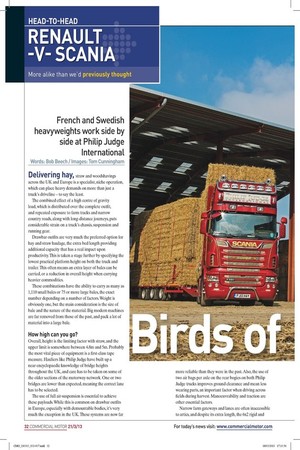
Page 23
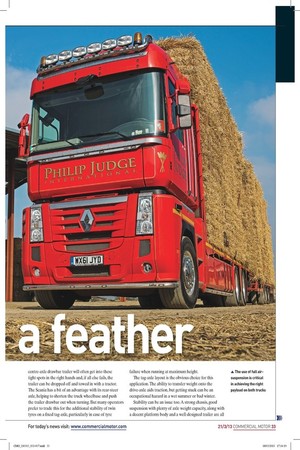
Page 24
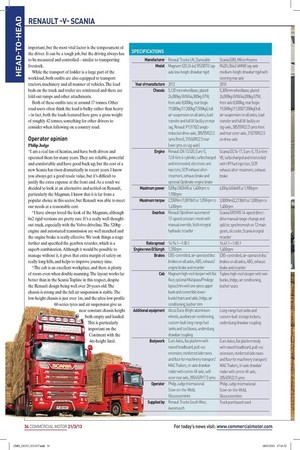
Page 26
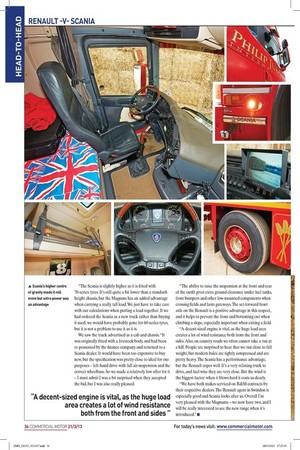
Page 27
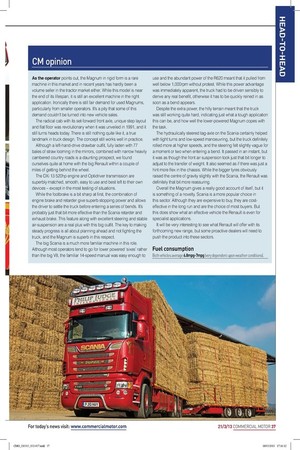
If you've noticed an error in this article please click here to report it so we can fix it.
Judge International Words: Bob Beech / Images: Tom Cunningham Delivering hay, straw and woodshavings across the UK and Europe is a specialist, niche operation, which can place heavy demands on more than just a truck's driveline — to say the least.
The combined effect of a high centre of gravity load, which is distributed over the complete outfit, and repeated exposure to farm tracks and narrow country roads, along with long-distance journeys, puts considerable strain on a truck's chassis, suspension and running gear.
Drawbar outfits are very much the preferred option for hay and straw haulage, the extra bed length providing additional capacity that has a real impact upon productivity. This is taken a stage further by specifying the lowest practical platform height on both the truck and trailer. This often means an extra layer of bales can be carried, or a reduction in overall height when carrying heavier commodities.
These combinations have the ability to carry as many as 1,110 small bales or 75 or more large bales, the exact number depending on a number of factors. Weight is obviously one, but the main consideration is the size of bale and the nature of the material. Big modern machines are far removed from those of the past, and pack a lot of material into a large bale.
How high can you go?
Overall, height is the limiting factor with straw, and the upper limit is somewhere between 4.8m and 5m. Probably the most vital piece of equipment is a first-class tape measure. Hauliers like Philip Judge have built up a near-encyclopaedic knowledge of bridge heights throughout the UK, and care has to be taken on some of the older sections of the motorway network. One or two bridges are lower than expected, meaning the correct lane has to be selected.
The use of full air-suspension is essential to achieve these payloads. While this is common on drawbar outfits in Europe, especially with demountable bodies, it's very much the exception in the UK. These systems are now far more reliable than they were in the past. Also, the use of two air bags per axle on the rear bogies on both Philip Judge trucks improves ground clearance and mean less wearing parts, an important factor when driving across fields during harvest. Manoeuvrability and traction are other essential factors.
Narrow farm gateways and lanes are often inaccessible to artics, and despite its extra length, the 6x2 rigid and centre-axle drawbar trailer will often get into these tight spots in the right hands and, if all else fails, the trailer can be dropped off and towed in with a tractor. The Scania has a bit of an advantage with its rear-steer axle, helping to shorten the truck wheelbase and push the trailer drawbar out when turning. But many operators prefer to trade this for the additional stability of twin tyres on a fixed tag-axle, particularly in case of tyre failure when running at maximum height.
The tag-axle layout is the obvious choice for this application. The ability to transfer weight onto the drive-axle aids traction, but getting stuck can be an occupational hazard in a wet summer or bad winter.
Stability can be an issue too. A strong chassis, good suspension with plenty of axle weight capacity, along with a decent platform body and a well-designed trailer are all important, but the most vital factor is the temperament of the driver. It can be a tough job, but the driving always has to be measured and controlled — similar to transporting livestock.
While the transport of fodder is a large part of the workload, both outfits are also equipped to transport tractors, machinery and all manner of vehicles. The load beds on the truck and trailer are reinforced and there are fold-out ramps and other attachments.
Both of these outfits tare at around 17 tonnes. Other road users often think the load is bulky rather than heavy — in fact, both the loads featured here gave a gross weight of roughly 42 tonnes, something for other drivers to consider when following on a country road.
Operator opinion Philip Judge "I am a real fan of Scanias, and have both driven and operated them for many years. They are reliable, powerful and comfortable and have good back-up, but the cost of a new Scania has risen dramatically in recent years. I know you always get a good resale value, but it's difficult to justify the extra expense at the front end. As a result we decided to look at an alternative and settled on Renault, particularly the Magnum. I know that it is far from a popular choice in this sector, but Renault was able to meet our needs at a reasonable cost.
"I have always loved the look of the Magnum, although 6x2 rigid versions are pretty rare. It's a really well-thoughtout truck, especially with the Volvo driveline. The 520hp engine and automated transmission are well matched and the engine brake is really effective. We took things a stage further and specified the gearbox retarder, which is a superb combination. Although it would be possible to manage without it, it gives that extra margin of safety on really long hills, and helps to improve journey time.
"The cab is an excellent workplace, and there is plenty of room even when double-manning. The layout works far better than in the Scania Topline in this respect, despite the Renault design being well over 20 years old. The chassis is strong and the full air suspension is stable. The low-height chassis is just over 1m, and the ultra-low-profile 60-series tyres and air suspension give us near constant chassis height both empty and loaded. This is particularly important on the Continent with the 4m-height limit. "The Scania is slightly higher as it is fitted with 70-series tyres. It's still quite a bit lower than a standardheight chassis, but the Magnum has an added advantage when carrying a really tall load. We just have to take care with our calculations when putting a load together. If we had ordered the Scania as a new truck rather than buying it used, we would have probably gone for 60-series tyres, but it is not a problem to use it as it is.
We saw the truck advertised as a cab and chassis. "It was originally fitted with a livestock body, and had been re-possessed by the finance company and returned to a Scania dealer. It would have been too expensive to buy new, but the specification was pretty close to ideal for our purposes — left-hand drive with full air-suspension and the correct wheelbase. So we made a relatively low offer for it — I must admit I was a bit surprised when they accepted the bid, but I was also really pleased. "The ability to raise the suspension at the front and rear of the outfit gives extra ground clearance under fuel tanks, front bumpers and other low-mounted components when crossing fields and farm gateways. The set-forward front axle on the Renault is a positive advantage in this respect, and it helps to prevent the front end bottoming out when climbing a slope, especially important when exiting a field.
"A decent-sized engine is vital, as the huge load area creates a lot of wind resistance both from the front and sides. Also, on country roads we often cannot take a run at a hill. People are surprised to hear that we run close to full weight, but modern bales are tightly compressed and are pretty heavy. The Scania has a performance advantage, but the Renault copes well. It's a very relaxing truck to drive, and fuel-wise they are very close. But the wind is the biggest factor: when it blows hard it costs us dearly.
"We have both makes serviced on R&M contracts by their respective dealers. The Renault agent in Swindon is especially good and Scania looks after us. Overall I'm very pleased with the Magnums — we now have two, and I will be really interested to see the new range when it's introduced." • SPECIFICATIONS Manufacturer Renault Trucks UK, Dunstable Model Magnum 520.26 6x2 RSDBTG tagaxle low-height drawbar rigid Scania (GB], Milton Keynes R620 LB6x2 4M N B tag-axle medium-height drawbar rigid with steering rear axle Year of manufacture Chassis 2012 5,120 mm wheelbase, plated 26,000kg GVW/44,000kg GTW, front axle 8,000kg, rear bogie 19,000kg (11,500kg/7,500kgJ, full air-suspension on all axles, load transferand fuLL lift facility on rear tag, Renault P13170/2 singlereduction drive-axle, 385/55R22.5 tyres (front], 315/60R22.5 rear (twin tyres on tag-axle) 2010 5,300mm wheelbase, plated 26,000kg GVW/44,000kg GTW, front axle 8,000kg, rear bogie 19,000kg (11,500/7,500kg) full air-suspension on all axles, load transfer and full lift facility on tag-axle, 385/55R22.5 tyres front and rear steer-axle, 315/70R22.5 on drive-axle Engine Renault DXi 13.520, Euro-5, 12.8-litre 6-cylinder, turbocharged and intercooled, electronic unit injectors, SCR exhaust aftertreatment, exhaust brake and optional Optibrake engine brake Maximum power 520hp (382MM at 1,400rpm to 1,90Orpm Maximum torque 2,550Nm ft1,8811.bft) at 1,050rpm to 1,45Orpm Gearbox Renault Optidriver automated 12-speed constant-mesh with manual override, Voith integral hydraulic retarder Scania DC16-17, Euro-5, 15.6-litre V8, turbocharged and intercooled with HI Plfuel injection, SCR exhaust after-treatment, exhaust brake 620hp (456kW) at 1,900rpm 3,000Nm(2,213lbfd at 1,000rpm to 1,40Orpm Scania G RS905 14-speed directdrive manual range-change and splitter, synchromesh on 12 main gears, oil cooler, Scania integral retarder Ratio spread 14.94:1-1.00:1 Engine revs fa 56mph 1,350rpm Brakes EBS-controlled, air-operated disc brakes on all axles, ABS, exhaust/ engine brake and retarder Cab Magnum high-roof sleeperwith flat floor, optional Multipass/Privilege Layout/trim with one-piece upper bunk and convertible lowerbunk/chairs and table, fridge, air conditioning, leather trim 1641:1-1.00:1 1,40Orpm EBS-controlled, air-operated disc brakes on all axles, ABS, exhaust brake and retarder Topline high-roof sleeper with twin bunks, fridge, air conditioning, Leather seats Additional equipment Alcoa Dura-Bright aluminium wheels, auxiliary airconditioning, custom-built long-range fuel tanks and tool boxes, underslung drawbarcoupling Bodywork Euro Axles, flat platform with raised headboard, pull-out extension, reinforced side raves and floor for machinerytransporl/ MAC Trailers, tri-axle drawbar trailerwith centre-lift axle, selfsteer rear axle, 205/65/R17.5 tyres Operator Philip Judge International Stow-on-the-Wold, Gloucestershire Supplied by Renault Trucks South West, Avonmouth Long-range fuel tanks and custom-built storage lockers, underslung drawbar coupling Euro Axles, flat platform body with raised headboard, pull-out extension, reinforced side raves and floor for machinery transporl/ MAC Trailers, tri-axle drawbar trailer with centre-lift axle, 205/65R22.5 tyres Philip Judge International Stow-on-the-Wold, Gloucestershire Truck purchased used CM opinion As the operator points out, the Magnum in rigid form is a rare machine in this market and in recent years has hardly been a volume seller in the tractor market either. While this model is near the end of its lifespan, it is still an excellent machine in the right application. Ironically there is still fair demand for used Magnums, particularly from smaller operators. It's a pity that some of this demand couldn't be turned into new vehicle sales.
The radical cab with its set-forward front axle, unique step layout and flat floor was revolutionary when it was unveiled in 1991, and it still turns heads today. There is still nothing quite like it, a true landmark in truck design. The concept still works well in practice.
Although a left-hand-drive drawbar outfit, fully laden with 77 bales of straw looming in the mirrors, combined with narrow heavily cambered country roads is a daunting prospect, we found ourselves quite at home with the big Renault within a couple of miles of getting behind the wheel.
The DXi 13 520hp engine and Optidriver transmission are superbly matched, smooth, easy to use and best left to their own devices — except in the most testing of situations.
While the footbrake is a bit sharp at first, the combination of engine brake and retarder give superb stopping power and allows the driver to settle the truck before entering a series of bends. It's probably just that bit more effective than the Scania retarder and exhaust brake. This feature along with excellent steering and stable air-suspension are a real plus with this big outfit. The key to making steady progress is all about planning ahead and not fighting the truck, and the Magnum is superb in this respect.
The big Scania is a much more familiar machine in this role. Although most operators tend to go for lower powered 'sixes' rather than the big V8, the familiar 14-speed manual was easy enough to use and the abundant power of the R620 meant that it pulled from well below 1,000rpm without protest. While this power advantage was immediately apparent, the truck had to be driven sensibly to derive any real benefit, otherwise it has to be quickly reined in as soon as a bend appears.
Despite the extra power, the hilly terrain meant that the truck was still working quite hard, indicating just what a tough application this can be, and how well the lower-powered Magnum copes with the task.
The hydraulically steered tag-axle on the Scania certainly helped with tight turns and low-speed manoeuvring, but the truck definitely rolled more at higher speeds, and the steering felt slightly vague for a moment or two when entering a bend. It passed in an instant, but it was as though the front air suspension took just that bit longer to adjust to the transfer of weight. It also seemed as if there was just a hint more flex in the chassis. While the bigger tyres obviously raised the centre of gravity slightly with the Scania, the Renault was definitely that bit more reassuring.
Overall the Magnum gives a really good account of itself, but it is something of a novelty. Scania is a more popular choice in this sector. Although they are expensive to buy, they are costeffective in the long run and are the choice of most buyers. But this does show what an effective vehicle the Renault is even for specialist applications.
It will be very interesting to see what Renault will offer with its forthcoming new range, but some proactive dealers will need to push the product into these sectors.
Fuel consumption Both vehicles average 6.8mpg-7mpg (very dependent upon weatherconditiona






































